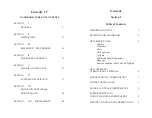
Reference Datum
An imaginary vertical plane from
which all horizontal distances are measured for balance
purposes.
Station
A location along the airplane fuselage usually
given in terms of distance from the reference plane.
Arm
The horizontal distance from the reference da
-
tum to the center gravity (CG) of an item.
Moment
The product of the weight of an item multi
-
plied by its arm. (Moment divided by a constant may
be used to simplify balance calculations by reducing the
number of digits.
Airplane Center of Gravity (CG)
The point at which
an airplane would balance if suspended. Its distance
from the reference datum is found by dividing the total
moment by the total weight of the airplane.
CG Arm
The arm obtained by adding the airplane’s
individual moments and dividing the sum by the total
weight.
CG Limits
The extreme center of gravity locations
within which the airplane must be operated at a given
weight.
Usable Fuel
The fuel available for flight planning
purposes.
Unusable Fuel
Fuel remaining after a runout test has
been completed in accordance with governmental regu
-
lations.
Standard Empty Weight
Weight of a standard air
-
plane including unusable fuel, full operating fluids and
full oil.
Basic Empty Weight
Standard empty weight plus any
optional equipment.
Payload
Weight of occupants, cargo and baggage.
Useful Load
Difference between take-off weight or
ramp weight if applicable and basic empty weight.
Maximum Ramp Weight
Maximum weight approved
for ground maneuvering. (It includes weight of start,
taxi and runup fuel).
Maximum Take-Off Weight
Maximum weight ap-
proved for the start of the take-off run.
Maximum Landing Weight
Maximum weight ap-
proved for the landing touchdown.
Zero Fuel Weight
Weight exclusive of usable fuel.
Tare
The weight of chocks, blocks, stand, etc. used
on the scales when weighing an airplane.
Jack Points
Points on the airplane identified by the
manufacturer as suitable for supporting the airplane
for weighing or other purposes.
ler.
Propeller Governor
Regulates the rpm of the engine/
propeller by increasing or decreasing the propeller pitch
through a pitch change mechanism in the propeller hub.
PERFORMANCE AND FLIGHT
PLANNING TERMINOLOGY
Climb Gradient
The ratio of the change in height
during a portion of a climb, to the horizontal distance
traversed in the same time interval.
Demonstrated Crosswind Velocity
The demonstrat
-
ed crosswind velocity is the velocity of the crosswind
component for which adequate control of the airplane
during take-off and landing was actually demonstrated.
The value shown is considered to be limiting. The value
in this handbook is that demonstrated by
Lancair test
pilots
and considered safe.
MEA
Minimum enroute IFR altitude.
Route Segment
A part of a route. Each end of that part
is identified by:
1) a geographical location; or
2) a point at which a definite radio fix
can be established.
Throttle Control
Used to control power by intro
-
ducing fuel-air mixture into the intake passages of
the engine. Settings are reflected by readings on the
manifold Pressure gauge.
Propeller Control
This control requests the pro
-
peller to maintain engine/propeller rpm at a selected
value by controlling blade angle.
Mixture Control
This control is used to set fuel
flow in all modes of operation and cuts
off fuel
completely for engine shutdown.
EGT (Exhaust Gas Temperature)
This indicator is
used to identify the lean and best power fuel flow for
various power settings.
CHT (Cylinder Head Temperature)
The indica
-
tor used to identify the operating temperature of the
engines’ cylinder(s).
TIT
The temperature of the exhaust gasses as they
enter the respective turbocharger. Copy data from
pages I-14 through I-18
Tachometer
Indicates the rpm of the engine/propel
-

























